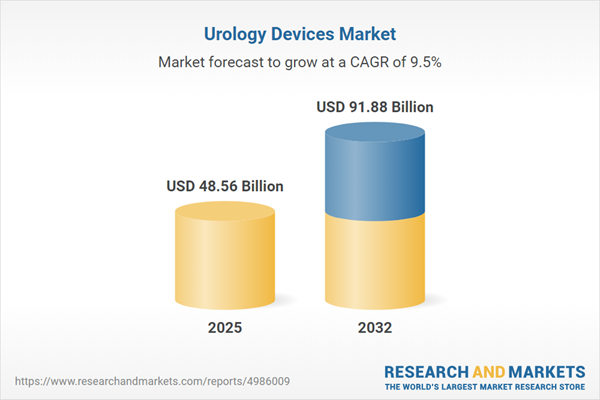Speak directly to the analyst to clarify any post sales queries you may have.
As the urology devices sector shifts in response to new care models, regulations, and technologies, healthcare executives and procurement leaders need precise, actionable market insights. Effective strategies are essential for resilience and operational advantage in a rapidly developing landscape.
Market Snapshot: Urology Devices Market Size and Growth Outlook
The global urology devices market is forecast to grow from USD 44.41 billion in 2024 to USD 48.56 billion in 2025 and reach USD 91.88 billion by 2032, at a compound annual growth rate (CAGR) of 9.51%. Rising demand for minimally invasive urology devices, the increasing integration of digital diagnostics, and the industry-wide focus on patient-centered care are key factors fueling this expansion. Healthcare organizations are also investing in talent development and evolving procurement models to meet new operational and regulatory requirements globally. These trends signal accelerating change and the need for agile, forward-thinking management.
Scope & Segmentation in the Urology Devices Market
For senior decision-makers, understanding the full scope of segmentation is critical when navigating complex procurement needs, technology adoption, and compliance structures. Each segment offers specific opportunities and challenges:
- Product Type: Continence management devices, penile prostheses, stone management tools, cystoscopes, nephroscopes, ureteroscopes, ureteral stents, and urodynamics systems support a spectrum of diagnostic and therapeutic requirements.
- Technology Platform: Disposable and reusable device formats are central to optimizing costs, reducing infection risks, and offering workflow adaptability for organizations of varied scale.
- Application Area: Devices are designed to address conditions such as benign prostatic hyperplasia, cancer therapeutics, urinary incontinence, kidney stones, and infections—aligning product portfolios with prevalent clinical demands.
- End User: Hospitals, ambulatory surgical centers, and specialized clinics each have distinct infrastructure and clinical workflow needs influencing purchasing strategies and product integration.
- Geography: The Americas, Europe, Asia-Pacific, the Middle East, and Africa present individual growth trajectories and regulatory frameworks, shaping both procurement methodologies and localization strategies.
- Industry Participants: Organizations such as Boston Scientific Corporation, Johnson & Johnson, Olympus Corporation, Medtronic plc, Stryker Corporation, Teleflex Incorporated, Coloplast A/S, Cook Medical LLC, KARL STORZ SE & Co. KG, and Richard Wolf GmbH offer evolving solutions to meet diverse commercial and clinical requirements in the urology domain.
Key Takeaways for Senior Decision-Makers
- Agile procurement processes are required to support the transition to minimally invasive and digitally enabled solutions, supporting both operational efficiency and clinical outcomes.
- Investments in digital diagnostics, including artificial intelligence, are shaping new models of evidence-based clinical decision-making and resource allocation.
- Software integration within devices presents ongoing challenges for compliance monitoring, with differing regulations across regions demanding strong oversight and flexibility.
- Collaborative partnerships involving device vendors, research organizations, and pharmaceutical firms are accelerating product innovation and reducing time to market for new technologies.
- Value-driven procurement models align sourcing with broader organizational goals, optimizing budget control and supporting scalable deployment in dynamic care environments.
Tariff Impact: Strengthening the Urology Device Supply Chain
Recent changes in U.S. tariff policy are prompting organizations to reassess sourcing strategies and enhance the resilience of supply chains. Shifting funding toward localized manufacturing and distribution is becoming central to maintaining uninterrupted device access. Reinforced compliance protocols and regional focus further help reduce vulnerabilities and ensure reliable delivery to care facilities.
Methodology & Data Sources
This analysis draws on primary research, including expert interviews, regulatory reviews, and peer-reviewed literature. Input from procurement professionals and senior leaders ensures that insights are directly aligned to evolving decision-making challenges in the urology devices market.
Why This Report Matters
- Offers comprehensive segmentation and operational analysis to support procurement, licensing, and strategy initiatives for B2B stakeholders in urology devices.
- Clarifies how compliance strategy and sourcing decisions influence risk management and resource allocation, giving organizations actionable pathways for device portfolio planning.
- Highlights opportunities to harness technology and collaborative models, helping leaders enhance operational performance and resilience in a changing market environment.
Conclusion
Active focus on strategic collaborations and technology-driven solutions enables healthcare organizations to strengthen their position in a dynamic market. Optimized procurement and operational choices are increasingly critical as the urology devices industry continues its progression.
Additional Product Information:
- Purchase of this report includes 1 year online access with quarterly updates.
- This report can be updated on request. Please contact our Customer Experience team using the Ask a Question widget on our website.
Table of Contents
3. Executive Summary
4. Market Overview
7. Cumulative Impact of Artificial Intelligence 2025
Companies Mentioned
The companies profiled in this Urology Devices market report include:- Boston Scientific Corporation
- Johnson & Johnson
- Olympus Corporation
- Medtronic PLC
- Stryker Corporation
- Teleflex Incorporated
- Coloplast A/S
- Cook Medical LLC
- KARL STORZ SE & Co. KG
- Richard Wolf GmbH
Table Information
| Report Attribute | Details |
|---|---|
| No. of Pages | 181 |
| Published | November 2025 |
| Forecast Period | 2025 - 2032 |
| Estimated Market Value ( USD | $ 48.56 Billion |
| Forecasted Market Value ( USD | $ 91.88 Billion |
| Compound Annual Growth Rate | 9.5% |
| Regions Covered | Global |
| No. of Companies Mentioned | 11 |









